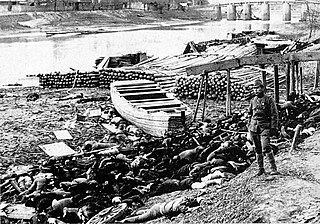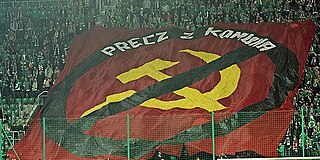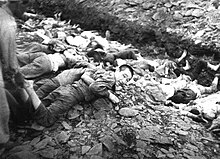
Democide refers to "the intentional killing of an unarmed or disarmed person by government agents acting in their authoritative capacity and pursuant to government policy or high command." The term was first coined by Holocaust historian and statistics expert, R.J. Rummel in his book Death by Government, but has also been described as a better term than genocide to refer to certain types of mass killings, by renowned Holocaust historian Yehuda Bauer. According to Rummel, this definition covers a wide range of deaths, including forced labor and concentration camp victims, extrajudicial summary killings, and mass deaths due to governmental acts of criminal omission and neglect, such as in deliberate famines like the Holodomor, as well as killings by de facto governments, for example, killings during a civil war. This definition covers any murder of any number of persons by any government.

State terrorism refers to acts of terrorism which a state conducts against another state or against its own citizens.

The Chinese Civil War was fought between the Kuomintang-led government of the Republic of China and the forces of the Chinese Communist Party (CCP), with armed conflict continuing intermittently from 1 August 1927 until 7 December 1949, resulting in a CCP victory and control of mainland China in the Chinese Communist Revolution.

Julio César Méndez Montenegro was a Guatemalan academic who served as the 34th president of Guatemala from July 1966 to July 1970. Mendez was elected on a platform promising democratic reforms and the curtailment of military power. The only civilian to occupy Guatemala's presidency during the long period of military rule between 1954 and 1986. Mendez had assumed the presidency under a pact in July 1966 that gave the armed forces carte blanche with respect to internal security matters and an effective veto over governmental policy. Nevertheless, his election and swearing in was considered a major turning point for the long military-led Guatemala. He was the first cousin of César Montenegro Paniagua whose kidnapping, torture and murder during the Julio César Méndez presidency is rumored to have been undertaken with presidential sanction.

The Red Terror was a campaign of political repression and executions in Soviet Russia and Soviet Ukraine, as well as occupied territories in Latvia, Lithuania, Estonia, and Finland, which was carried out by the Bolsheviks, chiefly through the Cheka, the Bolshevik secret police. It officially started in early September 1918 and lasted until 1922. Arising after assassination attempts on Vladimir Lenin and Trotsky along with the successful assassinations of Petrograd Cheka leader Moisei Uritsky and party editor V. Volodarsky in alleged retaliation for Bolshevik mass repressions, the Red Terror was modeled on the Reign of Terror of the French Revolution, and sought to eliminate political dissent, opposition, and any other threat to Bolshevik power. The decision to enact the Red Terror was also driven by the initial 'massacre of their "Red" prisoners by the office-cadres during the Moscow insurrection of October 1917', allied intervention in the Russian Civil War and the large-scale massacres of Reds during the Finnish Civil War in which 10,000 to 20,000 revolutionaries had been killed by the Finnish Whites.

The Communist Party of Indonesia was a communist party in the Dutch East Indies and later Indonesia. It was the largest non-ruling communist party in the world before its violent disbandment in 1965. The party had two million members in the 1955 elections, with 16 percent of the national vote and almost 30 percent of the vote in East Java. During most of the period immediately following the Indonesian Independence until the eradication of the PKI in 1965, it was a legal party operating openly in the country.

The Guatemalan Civil War was a civil war in Guatemala fought from 1960 to 1996 between the government of Guatemala and various leftist rebel groups. The government forces have been condemned for committing genocide against the Maya population of Guatemala during the civil war and for widespread human rights violations against civilians. The context of the struggle was based on longstanding issues of unfair land distribution. Wealthy Guatemalans, mainly European-descended, and foreign companies such as the American United Fruit Company had dominated control over much of the land, and paid almost zero taxes in return – leading to conflicts with the rural indigenous poor who worked the land under miserable terms.
The actions by governments of communist states have been subject to criticism across the political spectrum. Communist party rule has been especially criticized by anti-communists and right-wing critics, but also by other socialists such as anarchists, democratic socialists, libertarian socialists, orthodox Marxists, and Trotskyist communists. Ruling communist parties have also been challenged by domestic dissent. According to the critics, rule by communist parties has often led to totalitarianism, political repression, restrictions of human rights, poor economic performance, and cultural and artistic censorship.
Communist terrorism is terrorism perpetrated by individuals or groups which adhere to communism and ideologies related to it, such as Marxism–Leninism, Maoism, and Trotskyism. Historically, communist terrorism has sometimes taken the form of state-sponsored terrorism, supported by communist nations such as the Soviet Union, China, North Korea and Kampuchea. In addition, non-state actors such as the Red Brigades, the Front Line and the Red Army Faction have also engaged in communist terrorism. These groups hope to inspire the masses to rise up and start a revolution to overthrow existing political and economic systems. This form of terrorism can sometimes be called red terrorism or left-wing terrorism.

Mano Blanca, was a Guatemalan right-wing, anti-communist death squad, set up in 1966 to prevent Julio César Méndez Montenegro from being inaugurated as the president of Guatemala. While initially autonomous from the government, it was absorbed into the Guatemalan State's counter-terror apparatus and evolved into a paramilitary unit of the Guatemalan armed forces, and was responsible for the murder and torture of thousands of people in rural Guatemala. The group received support from the Guatemalan army and government, as well as from the United States. The group was officially known as the Movimiento de Acción Nacionalista Organizado which gives the acronym "MANO",. The group was variously known by its full name, by MANO, or most popularly by Mano Blanca, or "White Hand."
Several scholars have accused the United States of involvement in state terrorism. They have written about the US and other liberal democracies' use of state terrorism, particularly in relation to the Cold War. According to them, state terrorism is used to protect the interest of capitalist elites, and the U.S. organized a neo-colonial system of client states, co-operating with regional elites to rule through terror.

Large-scale killings and civil unrest primarily targeting members of the Communist Party (PKI) were carried out in Indonesia from 1965 to 1966. Other affected groups included alleged communist sympathisers, Gerwani women, trade unionists, ethnic Javanese Abangan, ethnic Chinese, atheists, so-called "unbelievers", and alleged leftists in general. According to the most widely published estimates at least 500,000 to 1.2 million people were killed, with some estimates going as high as two to three million. The atrocities, sometimes described as a genocide or politicide, were instigated by the Indonesian Army under Suharto. Research and declassified documents demonstrate the Indonesian authorities received support from foreign countries such as the United States and the United Kingdom.

Anti-communism is political and ideological opposition to communist beliefs, groups, and individuals. Organized anti-communism developed after the 1917 October Revolution in the Russian Empire, and it reached global dimensions during the Cold War, when the United States and the Soviet Union engaged in an intense rivalry. Anti-communism has been an element of many movements and different political positions across the political spectrum, including anarchism, centrism, conservatism, fascism, liberalism, nationalism, social democracy, socialism, leftism, and libertarianism, as well as broad movements resisting communist governance. Anti-communism has also been expressed by several religious groups, and in art and literature.

The Campaign to Suppress Counterrevolutionaries was the first campaign of political repression launched by the People's Republic of China designed to eradicate opposition elements, especially former Kuomintang (KMT) functionaries accused of trying to undermine the new Chinese Communist Party government. It began in March 1950 when the Central Committee of the Chinese Communist Party issued the Directive on elimination of bandits and establishment of revolutionary new order, and ended in 1953.

Mass killings under communist regimes occurred through a variety of means during the 20th century, including executions, famine, deaths through forced labour, deportation, starvation, and imprisonment. Some of these events have been classified as genocides or crimes against humanity. Other terms have been used to describe these events, including classicide, democide, red holocaust, and politicide. The mass killings have been studied by authors and academics and several of them have postulated the potential causes of these killings along with the factors which were associated with them. Some authors have tabulated a total death toll, consisting of all of the excess deaths which cumulatively occurred under the rule of communist states, but these death toll estimates have been criticized. Most frequently, the states and events which are studied and included in death toll estimates are the Holodomor and the Great Purge in the Soviet Union, the Great Chinese Famine and the Cultural Revolution in the People's Republic of China, and the Cambodian genocide in Democratic Kampuchea.

The Guatemalan genocide, also referred to as the Maya genocide, or the Silent Holocaust, was the massacre of Maya civilians during the Guatemalan Civil War (1960–1996) by successive US-backed Guatemalan military governments. Massacres, forced disappearances, torture and summary executions of guerrillas and especially civilians at the hands of security forces had been widespread since 1965, and was a longstanding policy of the military regime, which US officials were aware of. A report from 1984 discussed "the murder of thousands by a military government that maintains its authority by terror". Human Rights Watch has described "extraordinarily cruel" actions by the armed forces, mostly against unarmed civilians.

Crimes against humanity under communist regimes occurred during the 20th century, and they included forced deportations, massacres, torture, forced disappearances, extrajudicial killings, political terrorization campaigns, ethnic cleansing, and enslavement, as well as the deliberate starvation of people. Additional events included the commition of genocide, conspiracy to commit genocide, and complicity in genocide. Such events have been described as crimes against humanity.
Revolutionary terror, also referred to as revolutionary terrorism or reign of terror, refers to the institutionalized application of force to counter-revolutionaries, particularly during the French Revolution from the years 1793 to 1795. The term "Communist terrorism" has also been used to describe the revolutionary terror, from the Red Terror in Russia and Cultural Revolution in China to the reign of the Khmer Rouge and others. In contrast, "reactionary terror", often called White Terrors, has been used to subdue revolutions.
Benjamin Andrew Valentino is a political scientist and professor at Dartmouth College. His 2004 book Final Solutions: Mass Killing and Genocide in the 20th Century, adapted from his PhD thesis and published by Cornell University Press, has been reviewed in several academic journals.



















